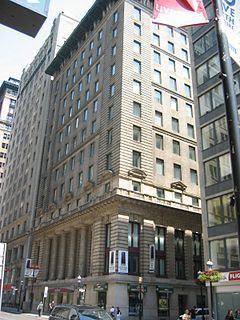Status Complete Construction started 1905 Height 55 m Floors 15 Architectural style Neoclassical architecture | Type Commercial offices Completed 1906 Opened 1906 Province Ontario | |
 | ||
Former names Montreal Trust Building Similar 197 Yonge Street, Canadian Pacific Building, Hotel Waverly, Standard Theatre, University Theatre | ||
Dover turnbull traction elevator at the trader s bank building
Trader's Bank Building is a 15-storey, 55.39 m (181.7 ft) early skyscraper completed in 1906 at 67 Yonge Street in Toronto, Canada. The building was designed by Carrère and Hastings, with construction beginning in 1905. It was the tallest building in Toronto and the entire British Commonwealth until the Canadian Pacific Building was completed in 1913. It remains one of Canada's few surviving skyscrapers of the early 20th Century.
Contents
- Dover turnbull traction elevator at the trader s bank building
- Map of Traders Bank Building 63 Yonge St Toronto ON M5E Canada
- References
Map of Trader's Bank Building, 63 Yonge St, Toronto, ON M5E, Canada
Construction of the building was marked by several accidents and one fatality. An engineer was scalded by a faulty steam injector in November 1905.
The building was innovative in its leasing arrangements. It was the first major Toronto building to introduce the New York system of leasing by the square foot. The building was completed by early December 1906, and the bank shortly moved into its new headquarters.
The building's height was fairly controversial at the time. A number of the city's public intellectuals and many of its architects expressed dismay at the prospect of skyscrapers. It would overload the property values and shade the streets, trapping the disease-causing "miasmas" that still lurked in the public imagination. The Globe newspaper complained: "in the next ten or fifteen years .... The chief retail thorofares will then look like a Colorado canyon." Other editorials on the skyscraper theme compared Toronto to New York:
but if the skyscraper habit grows, as there is every indication it will … the lower end of Yonge street and the central portion of King street will become dim sunless canyons such as one sees in the financial centre of New York.
The tall building did change the customary wind patterns at Yonge & Colborne. There were signs of urban canyon effect winds by the spring of 1909.
The City Architect in November 1907 promised it would not start a trend: There would be strict enforcement of the 200 foot height limit, which was still taller than the building itself. As it turned out, city council was usually persuaded to waive the height limits downtown, and the Traders' Bank was very shortly overtaken by even taller buildings.
